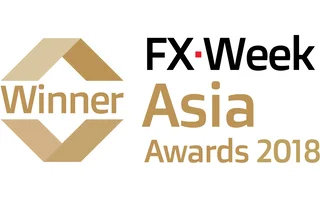
FX trading emerging markets – An Asia‑Pacific power shift


EBS examines the increase in uptake of its EBS Market platform – which was voted best emerging market FX trading platform in the FX Week Asia Awards 2018 – in Asia‑Pacific, and how this reflects a growing interest in currencies in the region.

Traditionally, EBS Market was the place for Group of 5 foreign exchange but, in recent years, the platform has made significant headway in emerging markets and the Asia-Pacific (APAC) region in particular. And, since the platform won a contract to provide technology for the China Foreign Exchange Trade System (CFETS) in 2016, tables have been turning.
“I would characterise 2018 as very much an emerging markets-focused year,” says Jeff Ward, global head of non-deliverable forwards (NDFs) and head of FX for Asia.
Emerging market currencies stealing the spotlight
CME Group acquired NEX, the owner of EBS, for $5.5 billion in November this year, and the now CME-owned EBS has been voted Best EM FX trading platform in Asia at the inaugural FX Week Asia Awards 2018. Between 2013 and 2016, EBS has seen growth in APAC FX trading volumes outpace that in G5 units, with the Chinese renminbi being a standout performer despite the lack of a free-floating structure for the currency.
“The USD/RMB is actually one of the most-traded FX pairs on EBS and it has seen stellar growth since 2016,” Ward adds.
It’s not just the renminbi that has seen an uptick in trading volumes. Volumes in the South Korean won NDF underwent 47% growth year-on-year on the platform, while the Indian rupee NDF clocked up a staggering 70% growth in the first six months of the year compared with 2017.
“In general, there has been a growing interest and healthy symbiotic growth in APAC currencies both deliverable and non-deliverable, while activity in G3 pairs has been more subdued,” Ward says.
“The proportion of activity that happens during Asian trading hours for Asian currencies has grown significantly, with over half of overall trading volumes being exchanged on our platform in the Asian time zone,” he adds.
Diversity driving the rise of Asia‑Pacific markets
Aside from the renminbi’s rise in significance on the world stage, the diversity of market participants as well as the fragmentation of the region in terms of countries and their local units have boosted volumes traded at the start of the global trading day.
Currency trading is dominated by a handful of large global banks and, to an increasing degree, a small number of non-bank market-makers. Institutional FX markets have a high degree of concentration across market-makers, as well as in terms of geographic distribution.
“There has been a growing interest and healthy symbiotic growth in APAC currencies both deliverable and non-deliverable, while activity in G3 pairs has been more subdued”
Jeff Ward, EBS
London is the world’s largest currency trading hub, with the US in second place. But, according to the latest available data from the Bank for International Settlements, activity and volumes are gradually tilting to the east.
NDFs, an important part of emerging markets currency trading, have also seen growth in volumes in recent years.
“There is a greater diversity of market participants in the APAC region than elsewhere. In Europe and the US there is a high concentration in terms of activity concentrated in London and New York,” says Ward.
“In Asia there are a number of trading hubs for FX, including Hong Kong, Singapore, Shanghai, Australia and, of course, Japan. This introduces a higher level of diversity not just in trading location but also in terms of counterparties as regional players play an important role in Asian currency trading,” he adds.
And local banks in the region are also getting more and more competitive.
While most of these local dealers are playing catch-up to their Western bank counterparts in terms of electronic trading capabilities, their growing might is noticeable in certain currencies already.
“These banks don’t necessarily want to compete with global dealers in EUR/USD, but many are very focused on their home currencies and a limited number of currencies in the region,” Ward says.
Technological limitations
But clients do trade differently from their European and US counterparts. APAC still sees a larger proportion of volumes going through voice than in other regions, where electronification and the use of algorithmic execution has spread faster.
Balancing the needs of these manual traders with prop shops deploying high-frequency trading strategies is a big ask.
“We spend a lot of time thinking about our rules and how to continue to ensure sound market ecology. We also do a lot of monitoring and policing on the platform to ensure that all types of clients get to play on a level field,” Ward says.
Some of these measures include minimum quote life times as well as a suite of analytical tools that allow customers to compare and benchmark their execution outcomes against their peers on the venue.
NEX Quant Analytics also provides market impact measurement tools and it allows more visibility into what’s happening on the platform. The company also launched NDF Ultra, a market data feed for the contract that seeks to mirror the successful launch of EBS Ultra, the platform’s premium data feed.
“NDF Ultra doesn’t have a minimum trading amount requirement on a daily basis, as while the market is growing it’s still a relatively small percentage of overall volumes. But we have already seen more than 15 clients sign up to NDF Ultra to date,” says Ward.
Conclusion
The buy side is also a big focus for EBS going into next year, and the firm will step up its sales efforts for EBS Institutional, the venue’s institutional asset manager-focused offering. “We will continue to work on getting clients signed up and trading on EBS Institutional in the APAC region and we will work on expanding our footprint in emerging markets, alongside the development of our existing franchise,” Ward concludes.
Sponsored content
Copyright Infopro Digital Limited. All rights reserved.
As outlined in our terms and conditions, https://www.infopro-digital.com/terms-and-conditions/subscriptions/ (point 2.4), printing is limited to a single copy.
If you would like to purchase additional rights please email info@fx-markets.com
Copyright Infopro Digital Limited. All rights reserved.
You may share this content using our article tools. As outlined in our terms and conditions, https://www.infopro-digital.com/terms-and-conditions/subscriptions/ (clause 2.4), an Authorised User may only make one copy of the materials for their own personal use. You must also comply with the restrictions in clause 2.5.
If you would like to purchase additional rights please email info@fx-markets.com